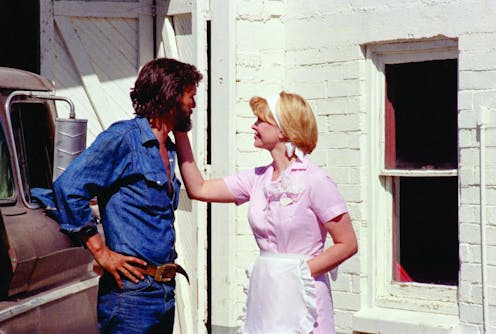
Alice Doesn’t Live Here Anymore, released on December 9 1974, is a fascinating composite of both 1970s New Hollywood and the legacy of the women-centred melodrama of the 1930s and ‘40s.
It is now mostly remembered as an early film directed by Martin Scorsese. But it was actually a project initiated by its lead actor, Ellen Burstyn, fresh off a series of acclaimed films including The Last Picture Show (1971), The King of Marvin Gardens (1972) and The Exorcist (1973).
The film would go on to be a significant commercial success, earn Burstyn the Academy Award for Best Actress, and inspire a much less gritty and profane sitcom that would last for nine seasons and featured only one (male) member of the original cast.
A step toward Hollywood
The subsequent critical reputation of Alice Doesn’t Live Here Anymore is somewhat skewed by its status as an atypical Scorsese film.
The director had only made three features: Who’s That Knocking at My Door (1967), Boxcar Bertha (1972) and Mean Streets (1973). Largely working outside the mainstream, he already had a significant critical reputation as a chronicler of flawed urban ethnic masculinity.
It is also fascinating to hear, this early in his career, Scorsese reminisce about how conscious he was of his growing reputation and of not wanting to be pigeonholed into a particular mode of cinema. He actively embraced the opportunity to make his first true Hollywood film.
He also felt the need to reorientate his focus away from men – though they still appear prominently – and embrace a female-centred narrative. There was also an insistence on working with women in key creative roles, and Scorsese followed Burstyn’s lead in terms of adjusting the script, encouraging improvisation and the nuance of performance.
Although women do feature prominently in subsequent Scorsese films such as New York, New York (1977), The Age of Innocence (1993) and Killers of the Flower Moon (2023), it can be argued Alice Doesn’t Live Here Anymore is Scorsese’s only narrative feature that centres on female experience.
It has been criticised for its overly mild feminism. But Burstyn was keen to make a movie that focused on the everyday pressures and desires of its carefully grounded female characters.
In the relatively inhospitable masculine terrain of New Hollywood, Alice Doesn’t Live Here Anymore is an outlier.
Scorsese is most commonly talked about as an iconoclast. But a key element of his career has also seen him operate within the system and maintain a capacity to work on large budgets and projects.
His desire to work with technologies such as 3D, large streaming companies, and actors like Leonardo DiCaprio (one of the few truly bankable actors in 21st-century cinema) have their roots in Scorsese’s employment by Warner Bros on this project.
He even expressed excitement about using the old Columbia Pictures sound stages. Alice Doesn’t Live Here Anymore would allow him to fuse contemporary – arguably feminist – sensibilities with the kind of star “package” designed in earlier times for actors such as Bette Davis and Joan Crawford.
Scorsese constantly toggles between cinema’s present and past, seeing them as inextricably entwined.
The path not taken
The film follows Alice (Burstyn) and her son Tommy as they travel from New Mexico to Arizona in pursuit of her dream of becoming a singer. It is one of many road movies made during this era and provides a fascinating time-capsule portrait of the desert and often ugly urban landscapes it travels through.
Although her pursuit of a career bubbles beneath the surface, the story is more concerned with the men Alice encounters and the camaraderie she forges with her fellow waitresses in a restaurant (the inevitable focus of the subsequent sitcom).
There is nothing particularly new or groundbreaking about this, but the film is most memorable for the small, often idiosyncratic scenes between Alice and her son. For the surprising moments of kindness, hard-won connection and violence Alice encounters. For the genuinely offbeat performance by Jodie Foster as Tommy’s worldly young friend. The needle drop of particular songs on the soundtrack.
Kris Kristofferson also provides an uncommonly soulful, weathered and comparatively gentle representation of masculinity.
Alice Doesn’t Live Here Anymore represents an important watershed in Scorsese’s career, and also a path not taken.
Although he has continued to work within and to the side of the mainstream, he has rarely produced a subsequent film with such warmth and sympathy for its central characters.
As a portrait of flawed humanity, it is miles away from his next feature, Taxi Driver (1976). After that, there was perhaps no turning back. Both for better and for worse.
Adrian Danks does not work for, consult, own shares in or receive funding from any company or organisation that would benefit from this article, and has disclosed no relevant affiliations beyond their academic appointment.
This article was originally published on The Conversation. Read the original article.







